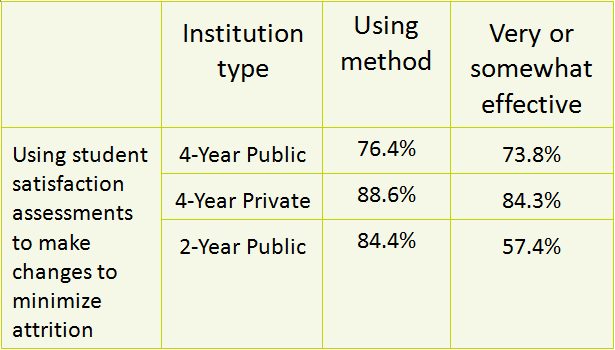enrollment
Building the case for college student satisfaction assessment
How satisfied are your students? You won’t know if you don’t ask. And if you don’t ask, you won’t have the data to build your case for student success initiatives.
Based on the results of our 2015 Student Retention and College Completion Practices Benchmark Report for Two-Year and Four-Year Institutions, student satisfaction assessments are cited by the majority as an effective method for making changes to minimize attrition.
Given that our current higher education environment is placing increasing expectations on performance-based funding and on student success measures, what will it take to get your campus to make student satisfaction assessment a priority?
Maybe it’s one of the several recent studies that link student satisfaction with student retention or higher institutional graduation rates. Or that we know that paying attention to the satisfaction levels of your currently enrolled students has a positive long-term effect on enrollment, student success, and future alumni engagement. And beyond retention efforts, for the 700 institutions we work with on an annual basis, they report using their satisfaction assessment data for strategic planning and accreditation.
When you think about your students’ experiences and what that means to your institution, there are two main areas of questioning:
- What information do I need to know about my students?
-Why are students enrolling at our institution?
-How do students feel about their overall experience?
-What are we doing well and what we could be doing better, according to our students?
-Are we moving in a positive direction? Have satisfaction levels improved?
- Which departments/colleagues would benefit from knowing this information?
–Admissions office for strengths to celebrate in student recruitment.
–Student affairs and academic affairs for prioritizing retention initiatives.
–Institutional research for valuable data on the student experience.
–Accreditation liaison to provide data for accreditation.
–Development office for supporting fundraising efforts by sharing data on satisfaction.
We often say that “data on the shelf has no power.” You have to use data in order for it to make an impact at your institution. Sharing the results with those departments listed above informs everyone of your identified priorities—your strengths and challenges. You will also want to further explore the data through focus group discussions on campus and with deeper dives into data subsets (typically by demographic variables). This allows you to be more prepared to take action because you will have a better understanding of what the results truly mean to your students.
We also encourage you to have brainstorming sessions across your campus departments to determine changes that can be made based on the priorities of the students. Are there places where you can make immediate changes? Are there areas that need to be part of a long-term plan? Are there ways that you can change student perceptions with more information?
Whatever changes you do implement, it is critical that you inform the students of the actions that have been taken as a result of them completing the survey. When they know that you are being responsive, you are more likely to see satisfaction levels improve with your next survey administration. And that’s important too: satisfaction assessment should not be a one-and-done activity, but something that is done on a regular cycle. Most institutions we are working with survey their students once every other year, to allow time to take action and to also administer other types of assessments.
Quick stats on how college student satisfaction assessment helps campuses
These results from our 2015 client survey illustrate just a few of the tangible benefits of student satisfaction assessment:
- 68 percent of our clients indicate that their year over year retention has improved.
- 45 percent report that they believe satisfaction assessment is contributing to retention improvement.
- 60 percent are seeing satisfaction increase over multiple years.
Questions about the most effective ways to use student satisfaction assessment data?
Please send me an email if you have any questions about conducting satisfaction assessment or using satisfaction assessment data. We can also schedule a time to talk if you would like to discuss your current goals and challenges related to assessment or student success.

